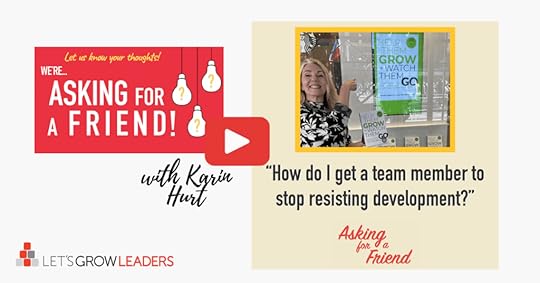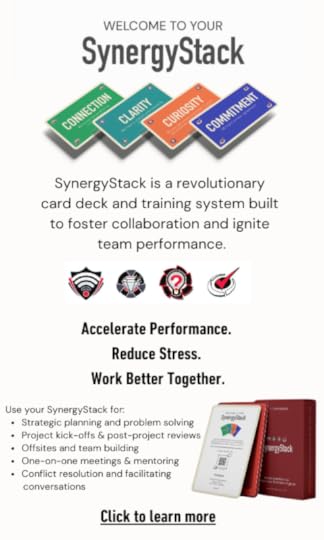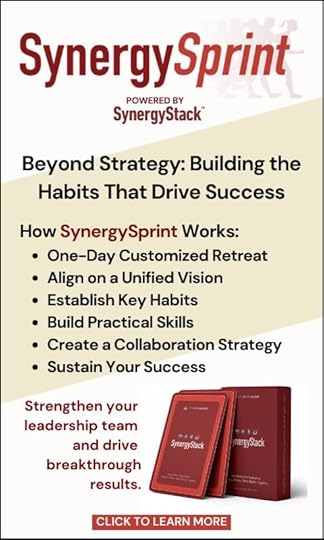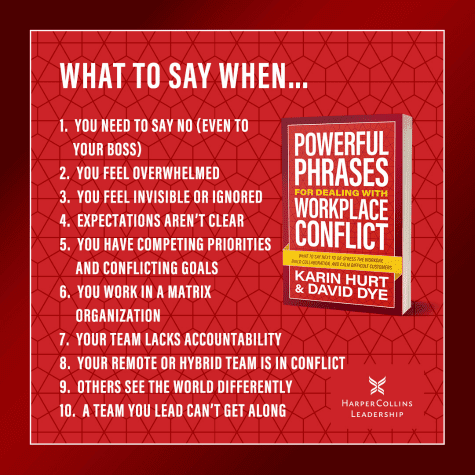David Dye's Blog, page 13
November 29, 2024
The Busy Leader’s Guide to Career Development Conversations
Episode 281: What if mastering career development conversations could be the key to transforming your team’s performance and keeping your best people engaged—no matter where they work?
If you’re a leader, you’ve likely faced the challenge of balancing results with investing in your people. In today’s fast-paced and hybrid work environments, having meaningful career development conversations isn’t just a nice to have. It’s critical to retaining talent and driving success. In this episode, Julie Winkle Giulioni, author of Help Them Grow or Watch Them Go: Career Conversations Organizations Need and Employees Want, unpacks how you can make career development a natural part of your leadership style, even with a packed schedule.
Powerful Conversation Starters: Learn practical, curiosity-driven questions to unlock your team members’ growth potential.Effortless Integration: Discover how to weave career development into your everyday interactions, even when time is tight.Remote Growth Strategies: Get actionable tips to ensure your remote and hybrid employees have equal opportunities to grow and thrive.Hit play now to master career development conversations that empower your team to grow, keep them engaged, and help you become the leader they need!
The Importance of Career Development Conversations[00:00] – The Leadership Game-Changer
David and Julie discuss how a supportive boss creates space for growth, setting the stage for the critical role of career development in leadership.
[05:35] – Develop Me or I’m History
Julie breaks down why career development conversations are essential to retaining and engaging talent, sharing insights into why growth opportunities are the number one reason people join or stay with organizations.
[08:27] – Connecting Growth to Results
Leaders often wonder, “Why should I focus on growth when I have results to deliver?” Julie explains how employee development drives innovation, customer satisfaction, and quality improvements.
[11:08] – Redefining Growth for Everyone
Growth doesn’t always mean promotions. Julie encourages leaders to reframe career development conversations to align with individual goals, whether learning new skills, building confidence, or expanding networks.
[17:23] – Small Moments, Big Impact
Learn how to turn everyday interactions into micro career development conversations that compound over time. Help leaders manage their time while still investing in their people.
[19:11] – The Power of Great Questions
Julie highlights the value of curiosity and shares practical questions. “What did you learn from that?” helps guide meaningful career development conversations.
[24:29] – From Titles to Action
Shift the focus from “What do you want to be?” to “What do you want to do?” Julie shows how this mindset change can open new opportunities and create actionable growth experiences.
[29:49] – Career Development at a Distance
As hybrid and remote work becomes the norm, Julie offers practical strategies to address proximity bias and create equitable career development opportunities for every team member.
[32:15] – Interrupting Bias with Awareness
Discover a simple yet powerful strategy for tracking interactions and ensuring equal growth opportunities for all team members, regardless of their location.
[42:39] – Supporting Aspirations Despite Performance Gaps
Julie provides a framework for navigating challenging conversations when employees aspire to grow but struggle with current responsibilities. She emphasizes how to use aspirations as a motivator.
The post The Busy Leader’s Guide to Career Development Conversations appeared first on Let's Grow Leaders.
November 25, 2024
Thanksgiving At Work: Creating a Culture of Gratitude on Your Team
For over a decade, we’ve been writing about the power of gratitude and appreciation in the workplace. It was fun for us to search “Let’s Grow Leaders” and then the words “thanksgiving,” “gratitude at work” and “appreciation” and read our own advice. We’ve had a good bit to say over the years, and we’re happy to say we’re consistent 😉
Gratitude at work matters.
These insights come from working with you and human-centered leaders like you. AND… hearing your frustrations. We’ve seen firsthand how a simple “thank you” can boost morale, strengthen a team, and create a culture where people feel seen and valued. When people feel seen, they feel safe. Safety leads to better engagement and contribution.
We also see the damage when leaders screw this up.
So, as Thanksgiving approaches in the United States, let’s get a bit meta here, and share some of our “gratitude at work” highlights.
Why Gratitude at Work Matters: More Than Just Saying ThanksGratitude isn’t just about being polite or sprinkling around a few “thank yous” like confetti. It’s about building an atmosphere where people feel connected and appreciated for their contributions. When people feel seen, they’re more motivated, engaged, and willing to help.
See True Gratitude: More than Pleasantries or Recognition
In this popular Asking for a Friend, Kerry Wekelo and I explore practical approaches for cultivating a culture of gratitude at work.

One of the best ways to build a culture of gratitude is to help the team celebrate.
Let’s start with why peer recognition is so important.
1. You can catch more good as it’s happening.
You get more of what you encourage and celebrate and less of what you ignore. There’s likely a lot of good going on that you don’t see firsthand. The celebration will be more meaningful because it can be more specific and timely.
2. It creates a cycle of collaboration and celebration.
When people feel appreciated and valued, they’re more likely to go the extra mile to help their teammates. When you make it easy for team members to recognize that extra mile, you’ve created a virtuous cycle of collaboration and celebration.
3. Peer recognition builds good habits and grows leaders
And third, you’re growing leaders. When you set the expectation that appreciation is a team sport, you’re equipping your team with valuable habits they can transfer to future leadership roles.
For specific ideas for better team recognition check out “Creative Peer Recognition: How to Get Better at Team Appreciation”.
Make Gratitude a Daily Habit: Building a System for AppreciationWhen leaders tell us they struggle with gratitude, “After all, why should I have to say thank you for someone doing their job,” (see “How to Be Great at Recognition, Even If It’s Not in Your DNA”) we encourage them to turn recognition and appreciation into a task.
Make a plan. Schedule it. Track it.
To get more ideas on how to keep appreciation flowing, read “How to Make Better Employee Recognition a Daily Habit”.
Avoiding the “Empty Thank You”: Get SpecificIf you’ve ever been on the receiving end of a vague “great job,” you know it doesn’t do much. Your can team can tell when your gratitude at work is real =, or when you’re just going through the motions. The key is to make your thanks specific, relevent and meaningful.
Instead of saying, “Good work,” try, “I appreciate how you took the time to walk the new team member through the process. That helped them get up to speed quickly. And as a result, we saved a week on this project.”
This Thanksgiving, aim to be intentional with your words. What did they do? How did it make a difference? Why does it matter?
Check out “Before You Forget: Stop and Do This Now” for more on why specific, meaningful appreciation is so important.
Taking Time for Yourself: Be Grateful for Your JourneyFinally, don’t forget to turn some of that gratitude inward. As you’re appreciating others, take a moment to reflect on your work and growth. What are you proud of? What have you learned this year? Maybe even jot down a few things you’re grateful for in your career. Being kind to yourself is just as important as recognizing others.
See Also: What Do You Like Most About Your Job?
And if, this year has been tough, take a moment to appreciate yourself for making it through. You’ve shown up. Done the work. And, made it to this moment. That’s something to be thankful for.
A Simple Thanksgiving Challenge: Share the GratitudeTo celebrate Thanksgiving this year, try a quick challenge: ask your team to share one thing they’re grateful for about someone they work with. It could be about their approach, a specific action, or how they bring a little joy to the team. The goal is to create a ripple of appreciation that extends beyond the holiday.
If you have a deck of our SynergyStack™ Team Development Cards, you can use the collaboration habits as prompts for thanksgiving and celebration. Invite each team member to share one habit they really appreciate about each team member.
A Decade of Building Better Teams Through GratitudeGenuine appreciation makes a difference. It’s not just about making people feel good—it’s about creating a culture where people feel seen, respected, and motivated to give their best. This Thanksgiving, take a moment to express gratitude for the people who make your work life richer. It’s a small act that can have a big impact.
Thank you for being on his journey with us, and for making gratitude a core part of your work. Here’s to more years of building strong, appreciative, human-centered teams together.
The post Thanksgiving At Work: Creating a Culture of Gratitude on Your Team appeared first on Let's Grow Leaders.
November 22, 2024
Why Humility is the Leadership Path to Productivity and Problem Solving
Do you think mastering your leadership path means always having the answers? What if embracing humility could make you a more effective and respected leader?
Leadership demands more empathy, adaptability, and connection than ever before. This episode explores how to lead with confidence while staying human. Learn how to shift from a traditional, bottleneck leadership style to one that inspires trust, builds resilience, and drives high performance.
Here’s what you’ll gain from tuning in:
Practical strategies for shifting from a “heroic” to a “humble” leadership model.Insights into building psychological safety and trust within your team.Techniques for leading with clarity and empowering others without micromanaging.Don’t miss this episode—unlock your full leadership potential and learn to lead with radical humility. Hit play now to start transforming your leadership style!
Redefining Your Leadership Path[00:00] The Humility of Leadership
Discover why leading today is inherently humbling. Learn how acknowledging what you don’t know is a key step on your leadership path.
[01:42] Early Lessons in Leadership
Hear how a childhood experience as a scout leader shaped a foundational understanding of accountability and leading by example.
[04:24] Heroic vs. Humble Leadership Path
Understand the transition from the outdated “heroic” model to a modern, human-centered leadership style that fosters trust and collaboration.
[05:25] The Three Cornerstones of Humility
Learn how self-awareness, relational leadership, and a growth mindset create a solid foundation for navigating your leadership path.
[08:02] The Five Key Shifts in Leadership
Unpack the practical steps for becoming a humble, results-driven leader, including leading relationally, cultivating trust, and empowering your team.
[12:28] Breaking the Cycle of Micromanagement
Explore actionable ways to empower your team while staying clear on outcomes and avoiding bottlenecks on your leadership path.
[16:20] Checking for Understanding
Master the skill of ensuring alignment with your team through simple but powerful communication techniques.
[18:32] Personal Transparency in Leadership
Learn how vulnerability—when approached appropriately—can build trust and strengthen relationships on your leadership path.
[23:27] Organizational Transparency for Better Decisions
Understand why overcommunicating goals and sharing critical information is vital for engaging your team and supporting their growth.
[27:25] Leadership Lessons from Ultra-Endurance
Draw inspiration from endurance sports. This includes focus, resilience, and embracing failure as you navigate challenges on your leadership path.
The post Why Humility is the Leadership Path to Productivity and Problem Solving appeared first on Let's Grow Leaders.
November 21, 2024
The Secret to Developing Employees Who Would Rather Not Grow
You’re trying to do the right thing. You want to be a good boss. You know developing employees is an important part of your job.
You’re eager to invest in your team’s growth, help them succeed, and make sure they’re ready for what’s next. But then, one of your team members looks at you and says, “I’m good. I don’t want to be developed.”
What do you do with that?
Let me tell you—this moment isn’t a dead end. It’s a pivot point.
I recently had the chance to talk with Julie Winkle Giulioni, who’s an absolute pro when it comes to employee development. Her take on this common conundrum? Not developing your team isn’t just frustrating—it’s a recipe for disaster, especially in a world that’s changing faster than ever.
Here’s the good news: you can turn this around. The key is to redefine what “development” even means.
Developing Employees When They Would Rather Not Grow: An Interview With Julie Winkle GiulioniSee More about Julie’s book with Bev Kaye Help Them Grow or Watch Them Go

When someone says they don’t want to be developed, they’re usually imagining extra work, more responsibility, or stepping outside their comfort zone in ways that feel overwhelming or unappealing. Who can blame them? Life is already busy enough.
But growth doesn’t have to mean adding more to their plate. Julie suggests reframing development as an opportunity to engage with the future and think about the role they want to play in it.
So, what does that look like? It’s not about piling on new projects or suggesting another course to take. Instead, focus on how they can evolve in the context of the work they’re already doing. Growth can be subtle. It can be about deepening their expertise, building stronger relationships, or finding more efficient ways to work.
Co-Creating a PlanOnce you’ve reframed development, it’s time to co-create a plan. Sit down with them and explore what excites them—or at least what feels sustainable. Maybe they don’t want to climb the corporate ladder, but they’d love to master a new skill or improve a process they care about.
Ask questions like:
“What’s something about your role that you’d like to get even better at?”“What would make your workday more rewarding?”“How do you see your career evolving over the next few years?”By aligning development with their interests, you’re not just helping them grow—you’re laying the foundation for a future where they can thrive.
Why It MattersHere’s the thing: the world won’t stop changing just because someone feels “good” where they are. Jobs evolve, industries shift, and what feels comfortable today might be obsolete tomorrow. By helping your team members develop—even when they’re resistant—you’re future-proofing their careers and your team’s success.
And let’s not forget the confidence boost that comes from even small wins. When someone feels more capable or sees the impact of their efforts, it’s amazing how their perspective on development can shift.
The Bottom LineWhen a team member tells you, “I’m good,” it’s not the end of the conversation. It’s an invitation to get curious, redefine growth, and meet them where they are.
Because here’s the thing: development isn’t about dragging someone along for the ride. It’s about showing them why the journey matters—and helping them find their reason to say yes.
Now, go co-create that plan. You’ve got this.
Has this ever happened to you? I’d love to hear how you handled it. Let’s swap stories in the comments. #AskingForAFriend
For more conversation with Jule see How Do I Develop Employees When There is Very Little Time?
You might also enjoy this popular article on performance feedback conversations. Performance Review: How to Respond to Lazy or Frustrating Feedback
The post The Secret to Developing Employees Who Would Rather Not Grow appeared first on Let's Grow Leaders.
November 16, 2024
Performance Review: How to respond to frustrating or lazy performance feedback
You’re right. You deserve high-quality, carefully considered feedback in your performance review. Your manager should take this seriously and do it right.
But often they don’t. It’s statistically likely that you (or a friend) will be blindsided by the performance feedback you receive. Let’s get ahead of it this year with some Powerful Phrases to ask for, and engage In a more meaningful conversation.
Powerful Phrases to Deal with Lazy, Vague, Frustrating Feedback

A few years ago, I wrote “Avoid These Infuriating Phrases in End-of-Year Feedback” to encourage managers to stop making stupid comments when giving a performance review.
This heartfelt post came from years of listening to high-performing employees vent their frustrations about frustrating phrases their managers said. If you’re a manager who struggles with performance reviews, please start there.
How to Respond to the Most Infuriating Kind of Performance ReviewFor the rest of you (or your friends), let’s prepare for that frustrating feedback this year and prepare you with some Powerful Phrases for when the conversation goes sideways.
1. “I don’t have much end-of-year feedback for you. You know you’re doing great.”I hate this one as much as you do. If you’re hearing this, you probably are doing great, but it doesn’t give you much to build on or improve.
Some options to start your empowered response:
“Wow, thanks so much! I appreciate your support. This year, I feel particularly proud about __________ (insert that accomplishment you expected them to bring up). I’m curious about your perspective on that _______(project, strategy, accomplishment). Why did that work from your perspective? What made that work so well, and how might I bring more of that into my work?”“Thank you! You know, one area I’m really working to improve on is _________. What is one suggestion you have for how I can be more effective in that arena?”“Thank you! I’m curious about what specifically you appreciate about what I’m doing here. I’m very focused on ensuring next year is even better, and I’d love your help in knowing what I should continue doing and ideas to help me really differentiate my performance next year.”2. “I rated you as meets expectations for your end-of-year feedback. Your performance really was an “exceeds” but I had to make the math work out.” Or, even worse, “I could only have one person in that category.”Okay, you have a serious right to be ticked off here. I’ve been there, on both sides of this awkward conversation.
And it’s probably too late to change the math or the rating. I know this because as a Verizon executive I’ve fought this battle many times for the high-performers on my team, and the answer was “pick one.”
Your manager may be as (or even more) frustrated than you.
In my article on infuriating phrases, my advice to your manager is to stay focused on results and behaviors, rather than the rating. And, to be clear about the criteria that they used to calibrate performance and where you met and exceeded those criteria and opportunities to improve in the future. To stay away from comparisons to other employees, or blaming other people for the rating they received.
And now, some options to start your empowered response:
“Oh, wow. That must have put you in a difficult situation. And, I’ve got to tell you, that makes me feel really ___________(insert emotion here, but try not to scream or cry).”“I’ve worked incredibly hard this year and I really don’t want to be having a similar conversation this time next year. Can we outline what I need to do for next year to make ‘exceeds’ (or whatever your rating equivalent is) the obvious rating? I’d love to build a plan to ensure I have the success I’m looking for.”“I really appreciate your support. And I’ve got to tell you I’m pretty frustrated. This affects my compensation too (if that’s true). I’d really like to talk to HR to express my concerns about this.”3. “I know we haven’t talked about this before, but _____”This one’s tricky because your manager certainly shouldn’t blindside you this way in your performance review. There are a few angles you might choose to take. If they’ve put something in writing that’s coming out of the blue, you might request to have that removed, requesting a fair chance to address it before it turns up in the documentation.
And, here are some empowering phrases that might be useful. 
If you hear this in your performance review, and you can’t think of any examples either, I’d recommend you push for some examples.
“I’m deeply committed to improving my performance in this arena. And, it’s really hard to understand what needs to change without some concrete examples.”“I really would like to understand this more. I’m struggling to come up with examples too.”“Can you please tell me more? I’d really like to get a better understanding of your concern here.”5. “I’ve gotten a lot of feedback from other people about your performance in this arena. Who? I’m not at liberty to say.As with most of these awkward performance review phrases, I would start with a gut check. If your manager is raising an issue and it feels true to you, then your best bet is to own it and work on it.
However, if this third-party performance review feedback feels unfair, then I would press for more information.
“Hmmm. That’s tricky. I don’t see it that way. It would be really helpful for me to talk directly with those concerned. Can you please ask them to come to me with their concerns so I have a chance to talk with them directly about it?”“Have you noticed this issue yourself? Does this seem like something that’s consistent with what you’ve observed?”“I’d like a chance to better understand this issue. Who do you suggest I talk with to learn more?”6. “Just write up your accomplishments and I’ll sign it.”It’s a great idea to submit your accomplishments. After all, you’re closer to the work you’ve done and the impact you’ve made.
Say yes, and then…
“I’d be delighted to write up my accomplishments (see How to help your boss give you a better performance review for tips on how to do that well).”“I would also really appreciate your feedback and perspective on my performance this year. When would be a good time for us to talk through my performance review?”“Here you go (hand them your accomplishments). I’m also really interested in your feedback on how I can make next year my best year ever. I got this great development discussion planner from Let’s Grow Leaders. I’d love to schedule some time to go through that.”While lazy, vague, and frustrating feedback can feel super irritating, it also gives you a chance to take responsibility for your career development. Ask for what you need and giveyour manager the opportunity to rise to the occasion. Sometimes their insights will surprise, and help you make that next step.
Related Articles12 Powerful Phrases For Navigating Challenging Workplace Conflict
How to Help Your Team’s Performance Stand Out for Better Recognition
The post Performance Review: How to respond to frustrating or lazy performance feedback appeared first on Let's Grow Leaders.
November 15, 2024
Building Resiliency: How to Become Your Own Coach
Are you ready to discover the power of building resiliency and how it can redefine your leadership journey?
In today’s fast-paced, high-stakes environment, it’s not enough to lead with purpose alone; resilience is what truly makes an impact. This episode dives into the essentials of resilience at work, exploring how you can inspire it within yourself and your team. Learn from leadership expert Simon T. Bailey as he shares insights that will help you boost productivity, reduce stress, and stay grounded—even when facing challenges head-on.
In this episode, you’ll gain:
Practical self-coaching questions to cultivate resilience and self-awareness every day.Tools to create meaningful connections and build a human-centered leadership style.Strategies to set boundaries and protect your energy, allowing you to lead with clarity and focus.Take a few minutes for yourself—press play and uncover the steps to becoming a resilient leader today!
Highlights of Building Resiliency with Simon T. Bailey[00:00:00] – Setting the Stage for Resiliency
Simon and host David Dye open the conversation with a powerful idea: people are learning how to be resilient by watching their leaders. Building resiliency begins with modeling presence, not just purpose, in the way you show up every day.
[00:02:18] – Learning Leadership at Disney
Simon recalls his early leadership lesson from a Disney executive: “Know who you are and why you’re here.” This revelation about creating moments rather than just doing a job was a pivotal step in his journey of building resiliency.
[00:04:57] – Inspiring Resilience in Your Team
A surprising statistic reveals that 82% of working Americans believe great leaders inspire resilience in others. Simon explains that building resiliency isn’t about giving directions but inspiring others by asking questions that lead to self-discovery.
[00:09:00] – Practical Questions for Self-Coaching
Simon introduces three practical questions to help leaders build resiliency: “What went well today?”, “What is right about you?”, and “How did you grow?” These questions foster a mindset of resilience by focusing on personal strengths and daily reflections.
[00:15:08] – The “Hurry, Worry, Ready, and Steady” Framework
Simon describes four personality archetypes—Hurry, Worry, Ready, and Steady—as a way of understanding how people approach challenges. This framework helps listeners identify their own tendencies in building resiliency.
[00:17:59] – The Importance of Asking “What Are You Feeling?”
Simon emphasizes the value of asking, “What are you feeling?” as a tool for self-reflection and emotional awareness, which are crucial steps in building resiliency. Leaders who understand their own emotions are better equipped to connect with their teams.
[00:24:17] – Learning to Be Vulnerable as a Leader
Simon shared a pivotal moment when he received tough feedback early in his career, pushing him to be vulnerable and open to growth. Embracing vulnerability, he argues, is essential for building resiliency in leadership.
[00:27:37] – Setting Boundaries to Protect Your Yes
Building resiliency includes setting boundaries. Simon explains the importance of saying “no” to protect what you value. Saying no to distractions allows you to stay focused on your core goals and commitments.
[00:32:15] – Navigating Others’ Reactions Without Losing Focus
Simon discusses how leaders are not responsible for others’ reactions. Building resiliency means focusing on your purpose and priorities rather than trying to manage how others may feel about your decisions.
[00:41:08] – Surfing Through Life’s Uncertainties
Using surfing as a metaphor, Simon explains that life will knock you off balance, but building resiliency is about getting back on the board. Each new wave is a chance to apply what you’ve learned and approach challenges with confidence.
The post Building Resiliency: How to Become Your Own Coach appeared first on Let's Grow Leaders.
November 12, 2024
Better Meetings: How to Give Everyone a Chance to Speak and Be Heard
How to Address a Meeting Dominator
How to Draw Others into the Conversation
How to Ensure Your Voice is Heard
The post Better Meetings: How to Give Everyone a Chance to Speak and Be Heard appeared first on Let's Grow Leaders.
November 11, 2024
Team Alignment: 5 Steps to Align Your Team on What Matters Most
When it comes to team alignment, nothing speaks louder than behavior. You know this: the best strategies fall flat without the right habits to back them up. So, how do you ensure your team is truly aligned and working together on what matters most?
It starts with you. If you’re leading a team, your behaviors and habits set the tone. You can’t just tell people what’s important—you’ve got to show them, consistently. The way you respond to challenges, celebrate wins, and communicate expectations creates the framework everyone else will follow.
The secret to success is ensuring that the most critical success habits spread throughout your department through deliberate modeling, communication, and reinforcement.
So how do you do that?
Get started with a team alignment meeting.
How to Host a Team Alignment Meeting in 5 StepsA team alignment meeting fast-tracks your key initiatives by identifying the practical habits vital for success. In this article, we outline an approach you can do yourself (or drop us a note, we’d love to help). This is a great activity for an end-of-year meeting, or to kick-off the new year.
Step 1: Get Clear on the Most Important InitiativeFirst, identify a strategic initiative that’s a priority for your team in the next 6-12 months. Choose a strategic initiative that meets three critical criteria:
Before your team alignment meeting, communicate this initiative with your team and why it’s critical. You want them ready to engage in a “how” conversation, not still debating the “should we?”
Step 2: Identify Key HabitsBring your team together and ask them to select one key habit that, if everyone consistently demonstrated it, would have a significant positive impact on the initiative’s success.
If your team has SynergyStack™ Card decks, have each team member sort through the cards and identify a habit that is:
Essential to the initiative’s success.Not currently widespread throughout the team.If you don’t yet have a SynergyStack™, invite team members to brainstorm a habit (be sure it’s practical and observable) and write their habit on an index card.
After everyone has selected their habit, have them share why they chose that habit and how they see it impacting the project.
This is where you’ll start to see patterns emerge: Are there common habits or themes? Are there certain collaboration dimensions (connection, clarity, curiosity, commitment) that show up more often?
Step 3: Align on Two Priority HabitsNow, narrow it down. As a team, choose two core habits that will have the greatest impact on driving success for the initiative. This isn’t just about consensus—it’s about choosing behaviors that will influence your culture and outcomes. Once you have your two habits, commit to them and get ready to build your leadership blueprint.
Step 4: Create a Leadership Blueprint to foster team alignmentTo ensure these habits stick, every leader on the team needs a game plan for modeling, communicating, and reinforcing them.
Modeling:Start with yourselves. Discuss specific, observable ways you can demonstrate these habits in your daily work. This isn’t just about big speeches or grand gestures—what are the small, daily actions that will show your team, “this is what good looks like”? Align on at least one or two consistent habits everyone will commit to practicing.
Communicating:Next, think about how you’ll communicate these habits throughout your department. It’s not just about emails or meetings. Think 5×5 communication (communicate messages five times, five different ways), and include a check for understanding to ensure the message sent is the message received.
Consider: How will you connect what you’re asking people to do with why it matters? How will you make these habits come to life with stories or examples? Agree on how you’ll cascade communication down and across your teams.
For some very practical communication tips see: Beyond Magical Thinking: How to Ensure Your Team Gets It
Reinforcing:Finally, look for opportunities to reinforce these habits over the next 30 days. How will you recognize and celebrate when you see people demonstrating them? How will you hold people accountable when the habits are ignored? f you want these habits to become the norm, they need to be what “people like us do.”
Step 5: Build in AccountabilityCreate a simple habit-tracking system to monitor progress. At your next team meeting, ask for updates: Who’s seen the habits in action? What’s working? Where are the obstacles? Adjust as needed, but stay focused on making these behaviors stick.
Take Action and Watch the ImpactWhen you and your leadership team consistently model, communicate and reinforce the right habits, you’ll see a ripple effect through your department. Aligned actions lead to better collaboration, stronger commitment, and ultimately, higher performance.
This isn’t just about another project plan—it’s about building a culture where everyone understands what success looks like and acts accordingly. That’s what team alignment really means. When your team knows where you’re headed, why it matters, and what behaviors will get you there, you’re not just managing projects—you’re building momentum.
And that momentum? It’s the fuel that will carry your team to success.
Gather your team, clarify your initiative, and choose those two vital habits. Then, go make it happen. The alignment you’re striving for starts with you.
The post Team Alignment: 5 Steps to Align Your Team on What Matters Most appeared first on Let's Grow Leaders.
November 9, 2024
How to Reset Expectations When You’ve Been “Too Nice”
Here’s how to reset performance expectations.
You’ve been so nice. You care about _____ (your team, your boss, your co-workers, your career, not rocking the boat…) so you’ve looked the other way when the destructive behaviors started creeping in.
You gave them the benefit of the doubt– because, you know, the being nice thing.
But NOW you’re looking around and thinking, “Wait, WHAT? How did we get HERE? How do you reset expectations when you’ve tolerated something before? #AskingforaFriend
I’ve heard variations on this issue at least 7 times this month.
“How did I let people scream and yell at me?”
“Why is my team thinking it’s okay to not meet our deadlines?”
“Why do I let my boss talk to me that way?”
“There’s this bully, but I don’t want to cause drama, so I just try to show up nice and accept it…”
And when we talk more there’s this moment of recognition, “It’s because I let them.”
And then the follow-up question. “Well, if I let this happen before, how can I reverse that tide and say it’s not okay.”

It’s not too late to teach people how to treat you. Here’s how to have the conversation. First, remember that it’s not nice to let people behave poorly. You are doing them, you and your work a disservice to allow them to continue destructive behavior.
See Also: Beyond Magical Thinking: How to Ensure Your Team Get’s It.
1. Start by owning it in one-on-one conversations. (CONNECTION)
“As we head into the new year, I’d like to reset expectations for our work together. And I take complete ownership for this because I have looked the other way with some things that aren’t working. They’re not serving you, me, our relationship, our customers, or our results…”
2. Get specific (without blame, and concrete examples). (CLARITY)“For example, this is the third time you’ve screamed at me this week.” Or, “We agreed that this report would be complete by Wednesday at 3 pm EST. You’ve turned it in on Friday every week this month.”
3. Describe your hope and vision for what’s possible. (CLARITY)“I care about our relationship and our work together. Here’s what success looks like from my perspective.”
4. Ask for what you need. (CLARITY)“Can we agree to ________.”
5. Get curious. (CURIOSITY)“What does this look like from your perspective?”
6. Move the conversation to a shared agreement with specific next steps. (COMMITMENT)“So to recap we’ve agreed to _________”
Just because you have accepted some negative behaviors in the past, does not mean you need to carry them into 2025.
The post How to Reset Expectations When You’ve Been “Too Nice” appeared first on Let's Grow Leaders.
November 8, 2024
Leadership Practices for Creating a Human-Centered Work Culture
Have you ever wondered if it’s possible to succeed in business while building a human-centered work culture and staying true to your values?
In today’s episode of Leadership Without Losing Your Soul, host David Dye dives into a profound conversation with Mark Silver, author of Heart-Centered Business: Healing from a Toxic Business Culture So Your Small Business Can Thrive. Whether you’re part of a small or large business, Mark’s insights on fostering a healthier workplace culture and practicing human-centered marketing will resonate with anyone looking to make a positive impact through their work.
In this episode, you’ll discover:
The five qualities every heart-centered leader needs to succeed and thrive in businessPractical ways to approach marketing that honor both the business and the customer’s dignityHow to balance different types of work for sustainable productivity and growthTake a moment to tune in to this episode and learn how to bring more compassion, patience, and authenticity into your business journey!
Building a Human-Centered Leadership Approach[00:38] Discover how a human-centered leadership approach can transform your work environment, helping you master communication and accelerate team performance while building a career with respect and influence.[01:30] Meet today’s guest, Mark Silver, a fourth-generation entrepreneur and heart-centered business expert. He shares his journey and introduces the essential qualities that help businesses thrive in a healthy, human-centered way.[04:16] Mark recalls his first leadership experience, reflecting on the transition from rookie paramedic to confident leader. His story illustrates how vulnerability and accountability play a huge role in effective leadership.[09:07] Vulnerability isn’t just a buzzword; it’s essential for successful leadership. Learn how embracing vulnerability can build stronger connections with your team and create a culture of trust and support.[18:55] Dive into the importance of mutual dependence in a team. You might be the leader, but you rely on your team to achieve great results every day. This perspective shift can transform how you lead and inspire others.Creating a Heart-Centered Business Culture[21:50] Patience is more than waiting; it’s about persistence. Hear Mark’s take on balancing patience with proactive leadership, using nature as a metaphor to understand the organic timing of growth and success.[28:15] Explore Mark’s unique approach to marketing that’s centered on empathy and respect. He explains how shifting from manipulative tactics to relationship-focused strategies can build lasting customer loyalty.[33:24] Marketing as a safe space? Yes! Learn how to create a non-pressured environment that allows potential clients to consider your services without feeling forced—leading to more meaningful connections.[45:36] Mark shares four types of work that every business needs: productivity, learning, gathering resources, and communication. Integrating these can create a sustainable workflow that benefits both you and your team.[59:43] Finally, Mark reminds us that urgency isn’t the answer. Instead, focus on mindful, human-centered practices that respect natural rhythms—because every act of business can, and should, be an act of love.The post Leadership Practices for Creating a Human-Centered Work Culture appeared first on Let's Grow Leaders.




